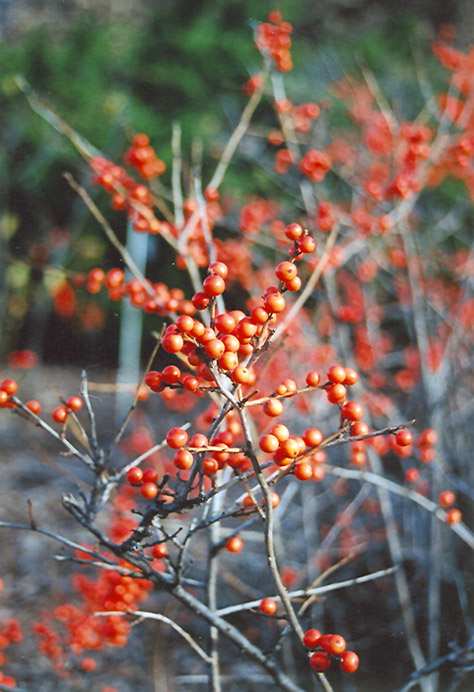Christmas Cheer Winterberry fruit Christmas Cheer Winterberry fruit (Photo courtesy of NetPS Plant Finder) Height: 5 feet Spread: 6 feet
Sunlight:
Hardiness Zone: 4a Other Names: Black Alder Description: A compact form of our native winterberry with bright tomato-red berries which are incredibly showy after the leaves have fallen in autumn, lasting into winter, requires a male pollinator to produce fruit; a better choice for smaller landscapes and gardens Ornamental Features Christmas Cheer Winterberry is primarily grown for its highly ornamental fruit. It features an abundance of magnificent tomato-orange berries from early to late fall. It has dark green deciduous foliage. The pointy leaves do not develop any appreciable fall color. Landscape Attributes Christmas Cheer Winterberry is a dense multi-stemmed deciduous shrub with a more or less rounded form. Its relatively fine texture sets it apart from other landscape plants with less refined foliage. This shrub will require occasional maintenance and upkeep, and is best pruned in late winter once the threat of extreme cold has passed. It is a good choice for attracting birds to your yard. Gardeners should be aware of the following characteristic(s) that may warrant special consideration; Christmas Cheer Winterberry is recommended for the following landscape applications; Planting & Growing Christmas Cheer Winterberry will grow to be about 5 feet tall at maturity, with a spread of 6 feet. It has a low canopy with a typical clearance of 1 foot from the ground, and is suitable for planting under power lines. It grows at a slow rate, and under ideal conditions can be expected to live for 40 years or more. This is a female variety of the species which requires a male selection of the same species growing nearby in order to set fruit. This shrub does best in full sun to partial shade. It prefers to grow in moist to wet soil, and will even tolerate some standing water. It is very fussy about its soil conditions and must have rich, acidic soils to ensure success, and is subject to chlorosis (yellowing) of the foliage in alkaline soils. It is somewhat tolerant of urban pollution. Consider applying a thick mulch around the root zone in winter to protect it in exposed locations or colder microclimates. This is a selection of a native North American species.
A NetPS Plant Finder tool
![]()
![]()
![]()
![]()
![]()
![]()
![]()
![]()
![]()
![]()
![]()
![]()
![]()
